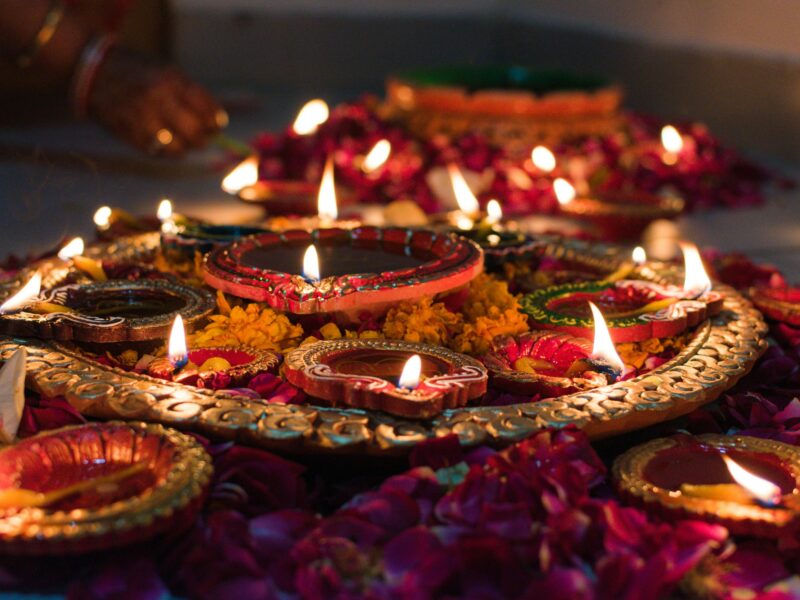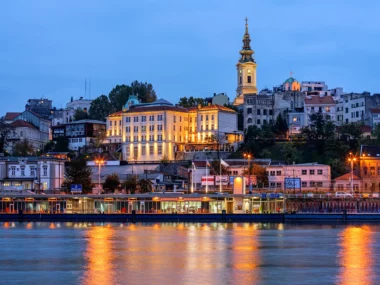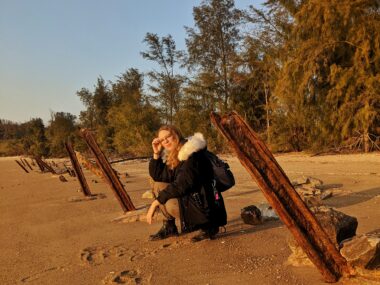Table of Contents
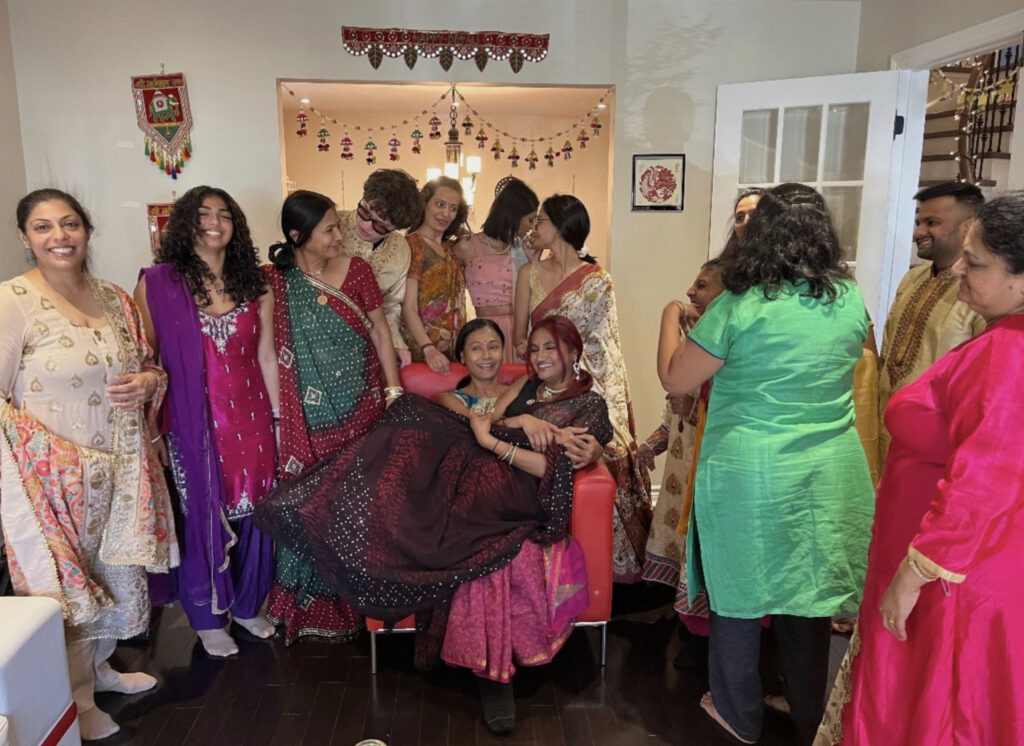
My Childhood Memories of our Diwali Traditions
If you’ve grown up in the West and don’t know much about Indian festivals, there’s probably one you’ve heard of year after year: Diwali. Most people outside of India call it the “festival of lights.” That is not wrong, but it is also like just calling Thanksgiving “the holiday with the turkey.” Technically true, but it barely scratches the surface. For me, growing up in a Gujarati Hindu household in Toronto, Diwali was always exciting, but I will be honest, as a kid I had no clue what it really meant.
What I did know was that our house turned into a full-on production. We lit little clay lamps called diyas and lined them across windowsills and staircases. They weren’t just decorations. Diyas symbolize the victory of light over darkness, knowledge over ignorance, and hope over despair. If you want a comparison, think of the way people light Advent candles at Christmas, or how a single candle in church can represent something much bigger than its flame. These are some of the Diwali traditions that carry meaning even if kids like me mostly saw them as part of the fun.
Then came the food. Every year my mom made her pilgrimage to the Gujarati grocery store for what we simply called “Diwali snacks.” Not your average chips and dip. It was an entire fried-food starter pack (sweet and savoury). Crispy fafda (savory chickpea flour strips), sticky-sweet jalebi (bright orange spirals drenched in syrup), and my personal favorite, kaju katli (cashew fudge cut into shiny diamond shapes).
In India, sweets are more than just really yummy treats. They’re a way of sharing happiness and good fortune. It is the same reason people hand out candy at Halloween or bake pies at Thanksgiving, food marks the occasion and makes it unforgettable (National Geographic, “Diwali Festival of Lights”).
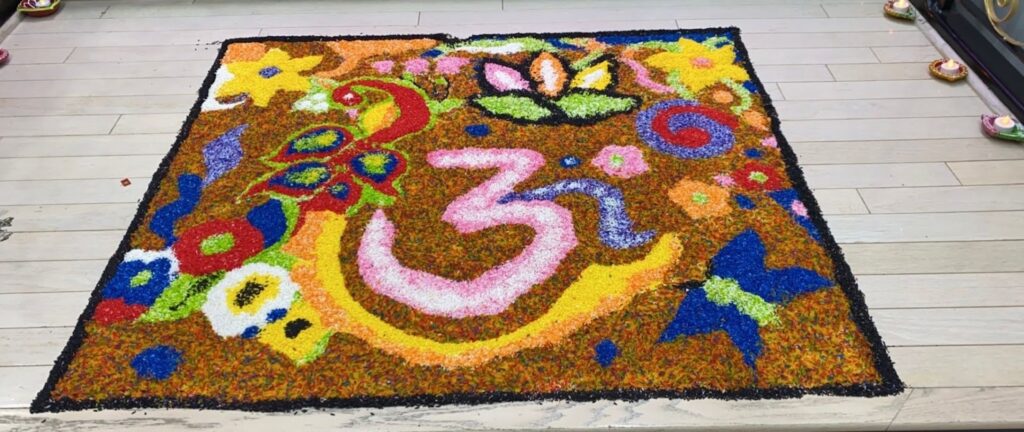
We also make rangoli, which is colorful floor art created with powders or flower petals. It was never just to make the house look pretty. Rangoli is meant to welcome the goddess Lakshmi, the bringer of prosperity and good fortune, into the home. To picture it, think of the way kids create elaborate sidewalk chalk drawings in summer, art that transforms a space and brings joy while it last.
And of course, there were fireworks. Every year my cousins and I lined up sparklers in the driveway like we were preparing for battle. Fireworks are not only about celebration, In Hindu culture they’re a way of banishing evil spirits and marking the triumph of good. In India, the sky explodes with smoke and color during Diwali. If you’ve ever been in a city on New Year’s Eve when the countdown hits zero and the whole skyline lights up, that comes close; except in India it happens night after night, and it feels like the entire country is in on it (Smithsonian, “How India Celebrates Diwali”).
The outfits were part of the magic too. We all dressed up in Indian clothes, which as a kid just meant whatever was in the house. I honestly thought all Indian clothes were the same. As I got older, I realized that certain outfits are reserved for certain ages. Interesting, right? It actually makes a lot of sense.
As an adult, I wear sarees now, something traditionally reserved for adult women. There is meaning here as well. New clothes symbolize renewal, leaving behind the old year and stepping into a fresh start. It is similar to the tradition of putting on something new for a milestone, whether that is New Year’s Eve, a graduation, or even prom night.
Looking back, I realize nobody explained any of this to me at the time. It was just “This is Diwali, now hold this sparkler.” And honestly, at that age, I didn’t really care. I was there for the snacks and the fun. But now I see how much meaning was packed into every detail, even if I didn’t notice it then. Growing up in the diaspora often means you celebrate traditions without fully understanding them. The why gets lost. And that is what I am trying to reconnect with now.
What is Diwali?

So here is the part I never paid attention to as a kid but wish I had. What is Diwali, really? It’s not just about snacks and sparklers. The word itself comes from “Deepavali,” which means “row of lights” in Sanskrit (Encyclopedia Britannica). Those lights aren’t random. They symbolize something bigger: good overcoming evil, knowledge overcoming ignorance, and hope overcoming despair (BBC).
The most famous story tied to Diwali is the return of Lord Rama to his kingdom after defeating the demon king Ravana. People lit lamps to welcome him home, which is why diyas are still such a big deal today. But that is just one version. In some parts of India, Diwali celebrates Lakshmi, the goddess of wealth and prosperity. In others, it is about Lord Krishna defeating a demon. The details shift, but the core message stays the same: light wins, darkness loses, and life goes on with a little more joy (National Geographic).
Here is the part most people in the West do not realize: Diwali isn’t just one night. It lasts five full days, and each day has its own rituals. The first day, called Dhanteras, is for buying gold or new household items to invite prosperity. The second, Naraka Chaturdashi, is tied to Krishna’s victory over a demon and is when homes are cleaned and prepared. The third day is the “main” Diwali that most people know, when families light diyas, worship Lakshmi, and gather together.
The fourth is about celebrating prosperity and, in many regions of India, marks the start of the new year. The fifth, Bhai Dooj, is about the bond between brothers and sisters. Imagine if Thanksgiving stretched into a five-day season with each day focusing on something different: family, gratitude, renewal, prosperity. That is how immersive these Diwali traditions really are.
So in many ways, Diwali is our New Year. It is not January 1st with champagne and resolutions, but it carries the same feeling of starting fresh. People wear new clothes, open fresh account books for businesses, and exchange wishes for a prosperous year ahead. It is a time to reset, to begin again, and to welcome light into the future.
The Difference in Celebrations of Diwali: India vs. Diaspora

When I eventually spent Diwali in India, everything I thought I knew about the Festival of Lights got flipped on its head. In Toronto, celebrations usually meant our family decorating the house, lighting a few diyas, setting off a couple of fireworks in the driveway, and maybe going to a temple event if there was one nearby. It was festive, but it felt like something we did inside our own little bubble.
India was on another level. It felt like the entire neighborhood was in a competition for “best decorated house,” and spoiler, everyone actually tried to win. People started preparing weeks ahead, which was wild to me because in Canada we would sometimes buy our fireworks the night before and call it a day. In India, by the time Diwali actually arrived, you could hear fireworks non-stop.
Not just at night, but in the middle of the day too, when you couldn’t even see them. At first I thought people were just wasting fireworks. Like, are you just trying to be annoying? But then I realized it’s basically about making as much noise as possible, and once you hear it all around you, it’s impossible not to feel the vibes.
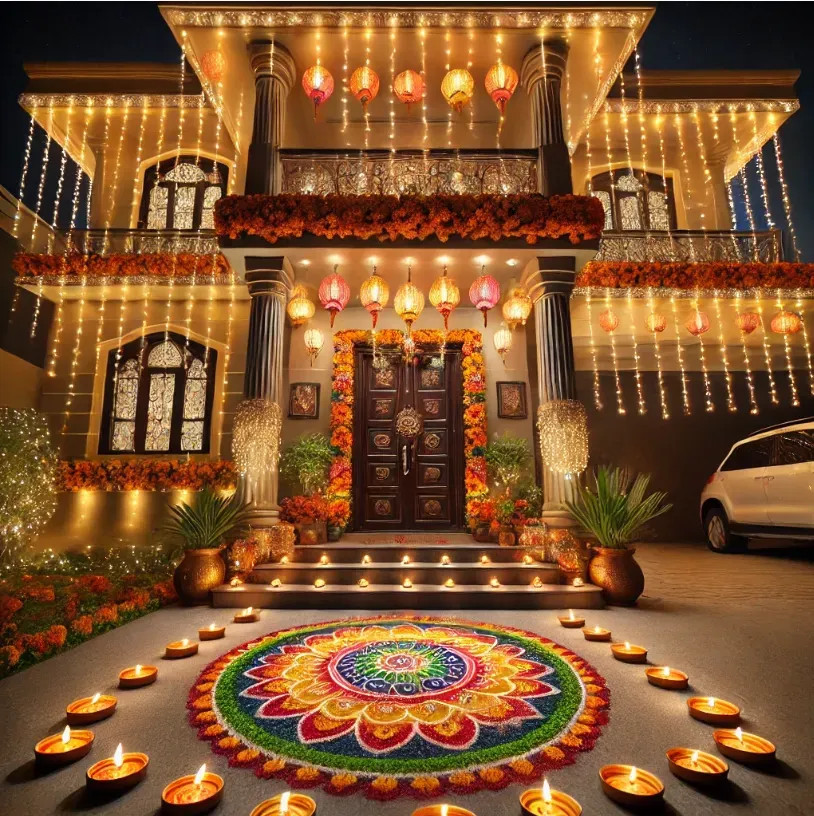
Temples were packed, people were shopping like it was Boxing Day, and everywhere you turned someone was handing you food. It felt like the whole country had pressed pause on their lives just to celebrate. That blew my mind because in Canada, even if it was Diwali, we still had school, work, errands. We would squeeze it in around regular life. In India, Diwali was life.
The biggest difference for me was how social it was. Back in Toronto it was just us, like my immediate family, extended family if they could make it and maybe one or two friends, and that was it. In India it was like having an open house but with the entire neighborhood. People were popping in, giving you sweets, dragging you to their place, like it was completely normal. I had never seen Diwali Traditions like that.
Diwali Food and Family Traditions
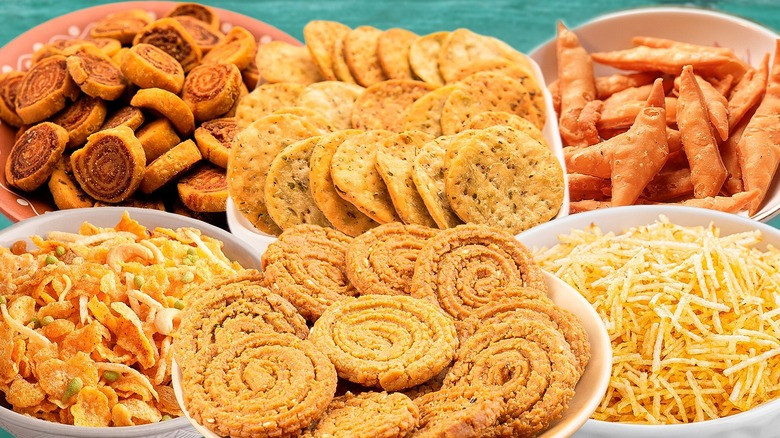
If I had to pick one thing that makes Diwali unforgettable, it would be the food. In my Gujarati household, food had main-character energy. My mom’s annual Diwali grocery run was legendary. She came home with boxes of fafda, which are long, crunchy strips made from chickpea flour, almost like a spiced cracker.
Then there was jalebi, bright orange spirals fried until crisp and then soaked in sugar syrup, sticky and sweet like a funnel cake at a carnival but ten times more intense. And of course, kaju katli, a diamond-shaped cashew fudge covered in edible silver leaf that looked fancy and disappeared instantly. In our house it never lasted more than a day because someone always stole the last piece and a full-blown snack war would break out.
When I went to India, the food made our Toronto stash look weak! Shops selling mithai, which just means Indian sweets, were everywhere, and they were packed to the brim. You could walk in and see trays piled high with laddoos, round balls made of flour, sugar, and ghee (a type of clarified butter), barfi, a dense milk-based sweet that comes in all colors and flavors, and pedas (I love these because we don’t get them often and it’s like a treat), soft milk fudge flavored with cardamom. Everything was fresh, colorful, and overwhelming. Imagine walking into Willy Wonka’s chocolate factory, but instead of candy bars you have rows and rows of handcrafted sweets with recipes that go back centuries.
The thing is, eating the sweets is only half the point. During Diwali, exchanging sweets is like exchanging good wishes. You show up at someone’s house with a box of mithai to say, “I want this year to bring you joy and prosperity.” It is similar to bringing cookies to a holiday party, or a bottle of wine to a dinner, except that in India people actually judge the quality of the sweets you bring. Nobody wants to be the person who shows up with the dry, mass-produced stuff (National Geographic).

And of course, the overeating was real. Everyone would swear they would only have “just one piece,” and then five later they would be sprawled on the couch pretending they were fine. By the end of the night the table looked like a dessert crime scene and somebody was already regretting their life choices.
That is the beauty of it though. The food is delicious, but it is more than just food. It brings everyone together, creates a kind of happy chaos, and builds memories that stick long after the sweets are gone. When I think about Diwali now, I do not just remember the taste of jalebi or kaju katli. I remember the arguments over who ate the last piece, the sugar highs, the family photos no one wanted to take, and the feeling that for those nights, being together was all that mattered.
Growing Up, Reconnecting, and Seeing Diwali Today
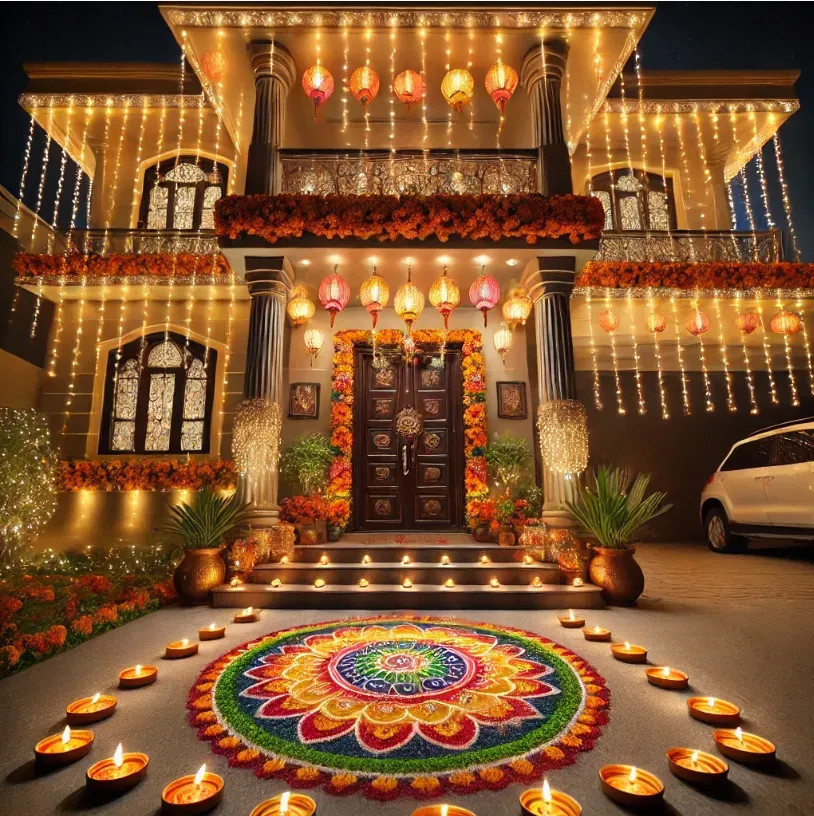
As I got older, Diwali started to feel different. When I was a kid, our house was always full of people. My aunts yelling (very loudly), nephews running around, snacks hidden in random places so nobody else could steal them, decorations that sometimes stayed up until the next year because no one could be bothered to take them down. Diwali was chaotic, but it was the best kind of chaos.
Eventually that energy faded. My cousins and I got older, everyone got busy with work and school, and the big Diwali nights turned into smaller ones. Sometimes it barely felt like a celebration at all. That is when I realized how much I missed it.
I also realized I had gone through most of my life celebrating without really knowing why. I never asked questions as a kid. I just showed up, ate my weight in fried food, lit some sparklers, and called it a day. As an adult, I started to actually care. Why do we light diyas? Why do we clean the whole house before Diwali? Why do we dress up in new clothes? Once I understood the meaning behind these Diwali traditions, it hit me differently. Lighting a diya feels calming now. Wearing a saree feels like a link to my culture, even if I still complain about how long it takes to put on.
Another change is how much more visible Diwali has become. Growing up in Toronto, most people outside our community had no idea it was even happening. Now I see Diwali displays in malls, big celebrations downtown, and even huge events in places like Times Square in New York (NYC Diwali in Times Square). Even the Canadian Parliament and the White House have hosted Diwali events in recent years (BBC). That would have blown my mind as a kid.
For me, that is the part that makes Diwali feel special again. Even if my own family does not celebrate as loudly as we used to, I know I am part of something bigger. Somewhere in the world, at the exact same time, there are people lighting diyas, eating way too many sweets, and arguing about who gets the last piece of kaju katli. Just like we did. And that makes me feel connected in a way I never really did when I was younger.
My Final Thoughts about Diwali
If you asked me as a kid what Diwali was, I would have said “the holiday where we eat too much and just get together as a family.” And honestly, that is still part of it. But now I see it as the moment in the year that pulls me back to who I am. Even if the celebrations look different in Toronto than they do in India, even if my family does not go all out like we used to, Diwali still gives me that reset.
So what is Diwali to me today? It is a reminder that no matter where I live, or how far I drift from tradition, I can always find my way back with a diya, a kaju katli, and maybe a sparkler in the driveway.
If you enjoyed this article about Diwali and my experience growing up in the Diaspora check out my other articles!
1. Garba: The Gujarati Dance That Celebrates Culture, Community, and Navratri
2. Toronto Unlocked: An Explorer’s Playbook for the 6ix
What does Diwali actually celebrate?
Diwali celebrates light over darkness and good over evil. Different parts of India have their own stories, but it always comes back to hope, renewal, and togetherness.
How do people celebrate Diwali in places like Canada?
It’s a little different here. Families light diyas, cook traditional food, visit friends, and sometimes go to temple events. It’s more home-based and personal, but still filled with warmth.
Why did you decide to write about Diwali and its meaning?
I’ve celebrated Diwali my whole life, but only recently started to understand what it truly means. Writing about it helped me reconnect with the festival’s roots.
How can people in the Indian diaspora stay connected to Diwali traditions?
Even small gestures matter. Lighting diyas, cooking family recipes, or gathering with friends keeps the spirit of the Festival of Lights alive wherever you are.
How can new generations learn the meaning of Diwali?
Through stories, shared traditions, and small acts that make it personal. Learning why we celebrate helps younger generations see Diwali as more than just a holiday.

